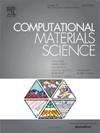Crystallization of h-BN by molecular dynamics simulation using a machine learning interatomic potential
IF 3.1
3区 材料科学
Q2 MATERIALS SCIENCE, MULTIDISCIPLINARY
引用次数: 0
Abstract
This study employs machine learning-driven molecular dynamics simulations to investigate the structure and physical properties of hexagonal boron nitride (h-BN) across a wide temperature range. A novel machine learning potential, neuroevolution potential, trained using first-principles calculations, is utilized for high-accuracy and efficient atomic-level simulations. Results reveal that slower cooling rates enhance the crystallinity and mechanical properties of h-BN. The unique temperature dependence of the elastic modulus and anisotropic thermal conductivity of h-BN are also elucidated. Furthermore, a predictive model is developed to estimate the tensile strength of low-density porous h-BN, providing a theoretical foundation for its potential applications in various fields such as electronics, aerospace, and energy storage.

求助全文
约1分钟内获得全文
求助全文
来源期刊

Computational Materials Science
工程技术-材料科学:综合
CiteScore
6.50
自引率
6.10%
发文量
665
审稿时长
26 days
期刊介绍:
The goal of Computational Materials Science is to report on results that provide new or unique insights into, or significantly expand our understanding of, the properties of materials or phenomena associated with their design, synthesis, processing, characterization, and utilization. To be relevant to the journal, the results should be applied or applicable to specific material systems that are discussed within the submission.
 求助内容:
求助内容: 应助结果提醒方式:
应助结果提醒方式:


